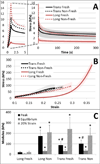How does tissue preparation affect skeletal muscle transverse isotropy?
- PMID: 27425557
- PMCID: PMC5056130
- DOI: 10.1016/j.jbiomech.2016.06.034
How does tissue preparation affect skeletal muscle transverse isotropy?
Abstract
The passive tensile properties of skeletal muscle play a key role in its physiological function. Previous research has identified conflicting reports of muscle transverse isotropy, with some data suggesting the longitudinal direction is stiffest, while others show the transverse direction is stiffest. Accurate constitutive models of skeletal muscle must be employed to provide correct recommendations for and observations of clinical methods. The goal of this work was to identify transversely isotropic tensile muscle properties as a function of post mortem handling. Six pairs of tibialis anterior muscles were harvested from Giant Flemish rabbits and split into two groups: fresh testing (within four hours post mortem), and non-fresh testing (subject to delayed testing and a freeze/thaw cycle). Longitudinal and transverse samples were removed from each muscle and tested to identify tensile modulus and relaxation behavior. Longitudinal non-fresh samples exhibited a higher initial modulus value and faster relaxation than longitudinal fresh, transverse fresh, and transverse rigor samples (p<0.05), while longitudinal fresh samples were less stiff at lower strain levels than longitudinal non-fresh, transverse fresh, and transverse non-fresh samples (p<0.05), but exhibited more nonlinear behavior. While fresh skeletal muscle exhibits a higher transverse modulus than longitudinal modulus, discrepancies in previously published data may be the result of a number of differences in experimental protocol. Constitutive modeling of fresh muscle should reflect these data by identifying the material as truly transversely isotropic and not as an isotropic matrix reinforced with fibers.
Keywords: Constitutive modeling; Material testing; Mechanical properties; Rigor mortis.
Copyright © 2016 Elsevier Ltd. All rights reserved.
Conflict of interest statement
Statement The authors have no financial or other conflicts of interest to report.
Figures




Similar articles
-
Transversely isotropic tensile material properties of skeletal muscle tissue.J Mech Behav Biomed Mater. 2010 Jan;3(1):124-9. doi: 10.1016/j.jmbbm.2009.03.004. Epub 2009 Apr 5. J Mech Behav Biomed Mater. 2010. PMID: 19878911 Free PMC article.
-
Skeletal muscle tensile strain dependence: Hyperviscoelastic nonlinearity.J Mech Behav Biomed Mater. 2016 Jan;53:445-454. doi: 10.1016/j.jmbbm.2015.08.041. Epub 2015 Sep 8. J Mech Behav Biomed Mater. 2016. PMID: 26409235 Free PMC article.
-
The anisotropic mechanical behaviour of passive skeletal muscle tissue subjected to large tensile strain.J Mech Behav Biomed Mater. 2013 Jan;17:209-20. doi: 10.1016/j.jmbbm.2012.09.001. Epub 2012 Sep 18. J Mech Behav Biomed Mater. 2013. PMID: 23127635
-
Simulation of active skeletal muscle tissue with a transversely isotropic viscohyperelastic continuum material model.Proc Inst Mech Eng H. 2013 May;227(5):571-80. doi: 10.1177/0954411913476640. Epub 2013 Feb 20. Proc Inst Mech Eng H. 2013. PMID: 23637267
-
A micromechanical model of skeletal muscle to explore the effects of fiber and fascicle geometry.J Biomech. 2010 Dec 1;43(16):3207-13. doi: 10.1016/j.jbiomech.2010.07.020. Epub 2010 Sep 16. J Biomech. 2010. PMID: 20846654 Free PMC article.
Cited by
-
Linking myosin heavy chain isoform shift to mechanical properties and fracture modes in skeletal muscle tissue.Biomech Model Mechanobiol. 2024 Feb;23(1):103-116. doi: 10.1007/s10237-023-01761-y. Epub 2023 Aug 12. Biomech Model Mechanobiol. 2024. PMID: 37568047
-
It's more than the amount that counts: implications of collagen organization on passive muscle tissue properties revealed with micromechanical models and experiments.J R Soc Interface. 2024 Feb;21(211):20230478. doi: 10.1098/rsif.2023.0478. Epub 2024 Feb 7. J R Soc Interface. 2024. PMID: 38320599 Free PMC article.
-
Systematic review of skeletal muscle passive mechanics experimental methodology.J Biomech. 2021 Dec 2;129:110839. doi: 10.1016/j.jbiomech.2021.110839. Epub 2021 Oct 26. J Biomech. 2021. PMID: 34736082 Free PMC article.
-
Investigating Passive Muscle Mechanics With Biaxial Stretch.Front Physiol. 2020 Aug 20;11:1021. doi: 10.3389/fphys.2020.01021. eCollection 2020. Front Physiol. 2020. PMID: 32973555 Free PMC article.
-
Modeling Skeletal Muscle Stress and Intramuscular Pressure: A Whole Muscle Active-Passive Approach.J Biomech Eng. 2018 Aug 1;140(8):0810061-8. doi: 10.1115/1.4040318. J Biomech Eng. 2018. PMID: 30003256 Free PMC article.
References
-
- Blemker SS, Pinsky PM, Delp SL. A 3D model of muscle reveals the causes of nonuniform strains in the biceps brachii. J. Biomech. 2005;38:657–665. - PubMed
-
- Calvo B, Ramírez A, Alonso A, Grasa J, Soteras F, Osta R, Muñoz MJ. Passive nonlinear elastic behaviour of skeletal muscle: Experimental results and model formulation. J. Biomech. 2010;43:318–325. - PubMed
-
- Cavanagh PR, Komi PV. Electromechanical delay in human skeletal muscle under concentric and eccentric contractions. Eur. J. Appl. Physiol. Occup. Physiol. 1979;42:159–163. - PubMed
MeSH terms
Grants and funding
LinkOut - more resources
Full Text Sources
Other Literature Sources

